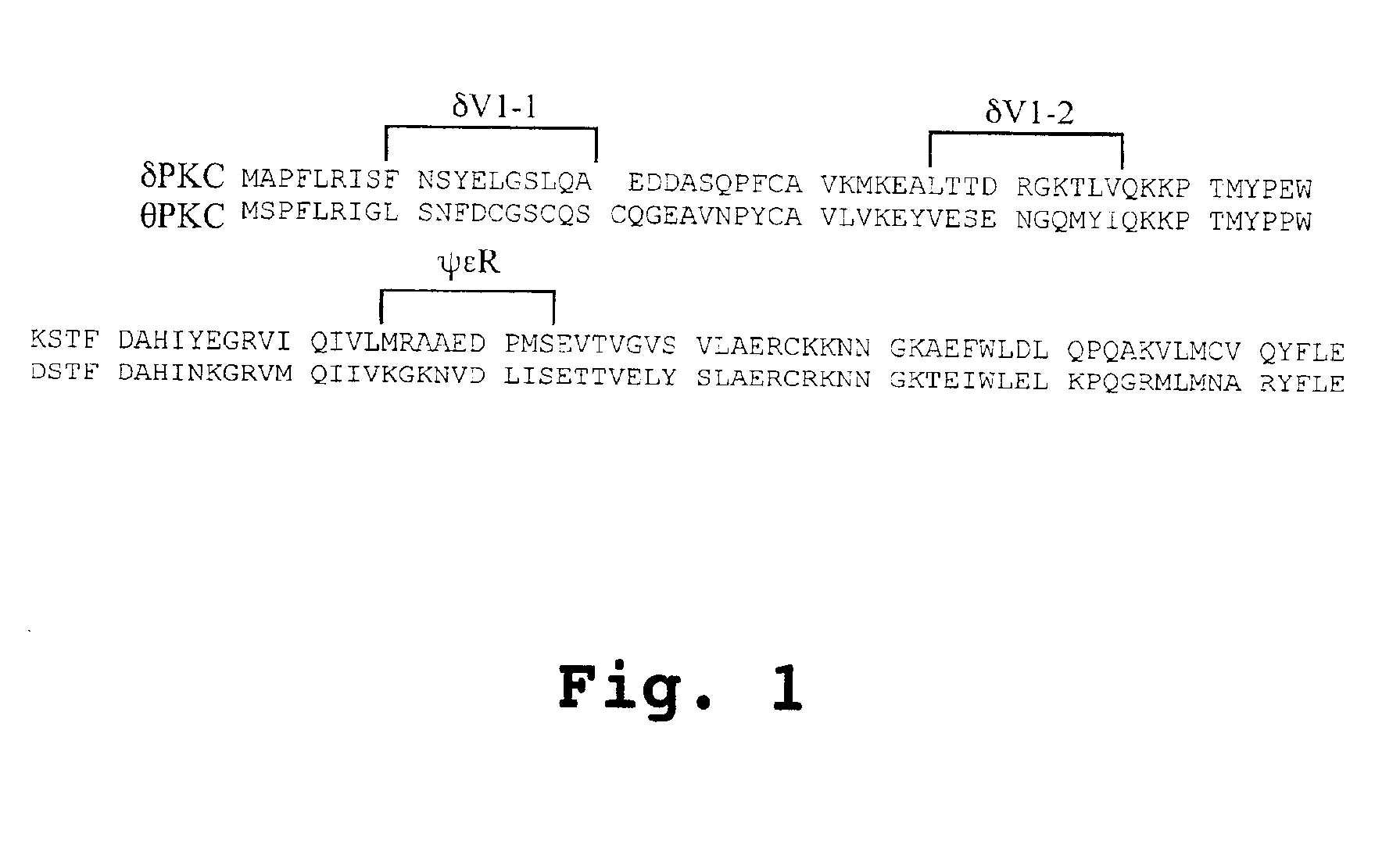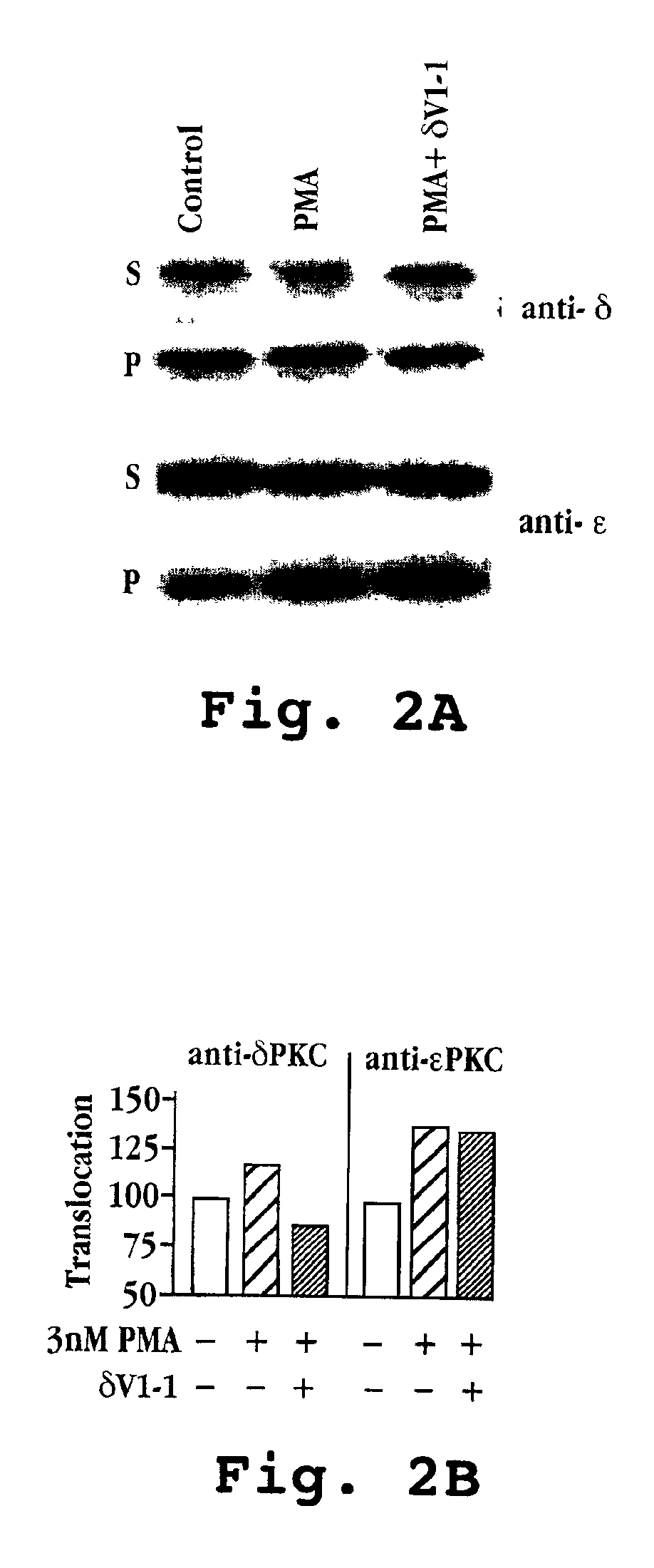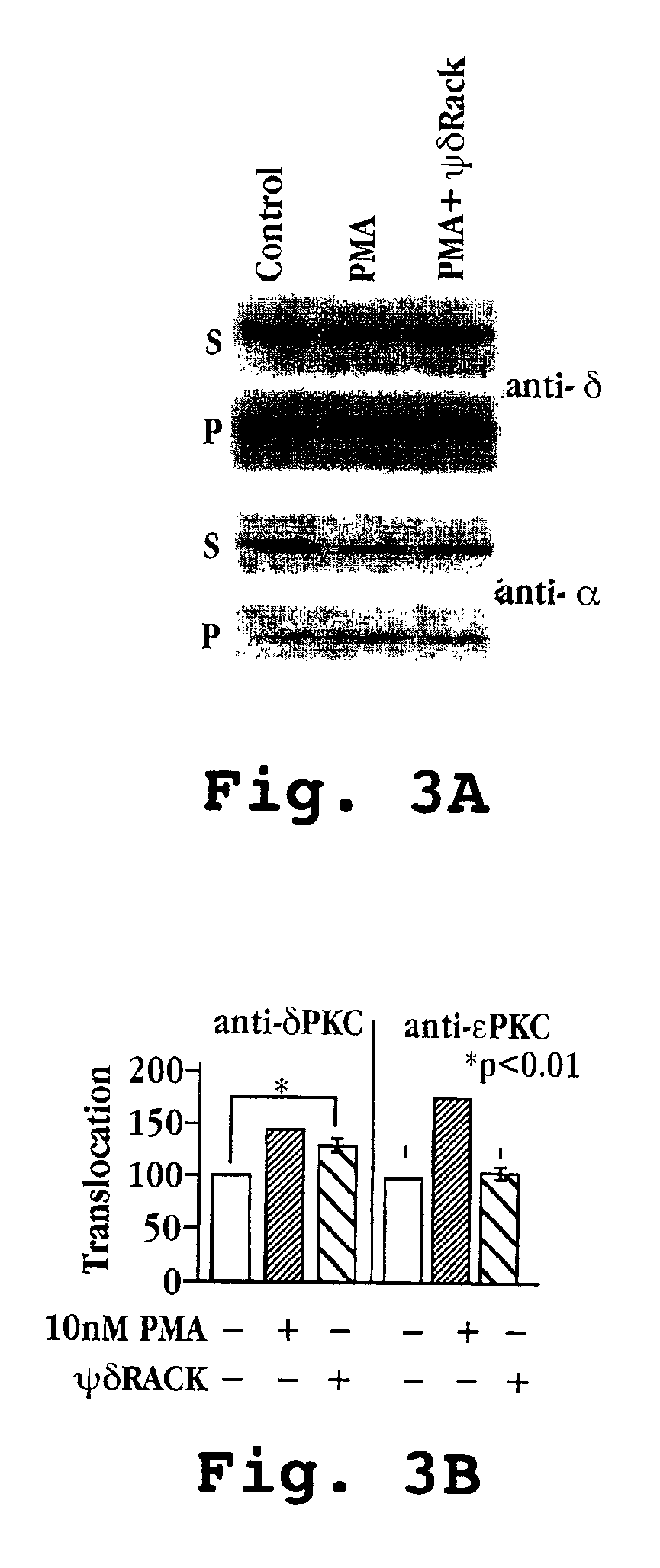Peptides for activation and inhibition of δPKC
a technology of peptides and activation and inhibition, which is applied in the field of peptides, can solve the problems of unknowing in the art whether or not pck peptide agonists and antagonists can be delivered, and achieve the effects of enhancing cellular or tissue damage, reducing or protecting cells and tissues from damage, and enhancing tissue damag
- Summary
- Abstract
- Description
- Claims
- Application Information
AI Technical Summary
Benefits of technology
Problems solved by technology
Method used
Image
Examples
example 1
Activity of δV1-1, δV1-2 and ψδRACK
[0247]A. Peptide Preparation
[0248]δV1-1 (SEQ ID NO:4) and ψδRACK (SEQ ID NO:6) were synthesized and purified (>95%) at the Stanford Protein and Nucleic Acid Facility. The peptides were modified with a carrier peptide by cross-linking via an N-terminal Cys-Cys bond to the Drosophila Antennapedia homeodomain (SEQ ID NO:8; Théodore, L., et al.; Johnson, J. A. et al., 1996b). In some studies not reported here, the peptides were lined to Tat-derived peptide (SEQ ID NO:9).
[0249]B. Peptide Delivery Into Cells
[0250]Primary cardiac myocyte cell cultures (90-95% pure) were prepared from newborn rats (Gray, M. O. et al.; Disatnik M.-H. et al.). The peptides δV1-1 and ψδRACK were introduced into cells at an applied concentration of 500 nM in the presence and absence of phorbol 12-myristate 13-acetate (PMA) at concentrations of 3 nm and 10 nm, respectively, for 10-20 minutes. In a third set of cells, the peptide δV1-1 was applied at a concentration of 500 nM in...
example 2
Peptide Administration to Isolated Cardiac Myocytes
[0252]The peptides δV1-1 and ψδRACK were prepared as described in Example 1.
[0253]Adult male Wistar rat cardiomyocytes were prepared on a Langendorff apparatus (van der Heide, R. S. et al.) by collagenase treatment (Armstrong, S. et al.). The cells were treated with δV1-1 at concentrations of 10 nM, 100 nM, 500 nM, and 1 μM in the presence or absence of 1 μM ψδRACK. βPKC-selective activator was used as a control.
[0254]For stimulated ischemia, adult myocytes treated in microcentrifuge tubes with δV1-1 and / or ψδRACK peptides conjugated to the carrier were washed twice with degassed glucose-free incubation buffer and pelleted. On top of a minimal amount of buffer, the cell pellets were overlaid with either a micro-balloon (Sig Manufacturing, Montezuma, Iowa) or with degassed buffer saturated with nitrogen, and sealed with an airtight top. Tubes were then incubated at 37 C for either 180 minutes or 90 minutes.
[0255]Cell damage was asses...
example 3
Ex vivo Peptide Administration to Whole Hearts and Effect on Cell Damage
[0256]Adult, male rats were anesthetized with i.p. avertin, and their hearts were rapidly removed and cannulated via the aorta for perfusion as described in the art (Colbert, M. C. et al.) using Langendorff set-up. Care was taken to have the hearts perfused within 90 seconds of removal. The hearts were perfused with oxygenated Krebs-Henseleit solution comprised of, in nmol / L, NaCl 120; KCl 5.8; NaHCO3 25; NaH2O4 1.2; MgSO4 1.2; CaCl2 1.0; and dextrose 10, pH 7.4 at 37 C.
[0257]After a 10-20 minute equilibration period, the hearts were perfused with δV1-1 peptide (SEQ ID NO:4) or with ψδRACK peptide (SEQ ID NO:6), prepared as described in Example 1 but conjugated to a Tat-derived peptide (Tat 47-57, SEQ ID NO:9), for 20 minutes. Perfusion was maintained at a constant flow of 10 mL / min with Krebs-Hanseleit solution containing 0.5 μM of the appropriate peptide. The Langendorff method employed used retrograde flow fr...
PUM
| Property | Measurement | Unit |
|---|---|---|
| Fraction | aaaaa | aaaaa |
Abstract
Description
Claims
Application Information
 Login to View More
Login to View More - R&D
- Intellectual Property
- Life Sciences
- Materials
- Tech Scout
- Unparalleled Data Quality
- Higher Quality Content
- 60% Fewer Hallucinations
Browse by: Latest US Patents, China's latest patents, Technical Efficacy Thesaurus, Application Domain, Technology Topic, Popular Technical Reports.
© 2025 PatSnap. All rights reserved.Legal|Privacy policy|Modern Slavery Act Transparency Statement|Sitemap|About US| Contact US: help@patsnap.com



